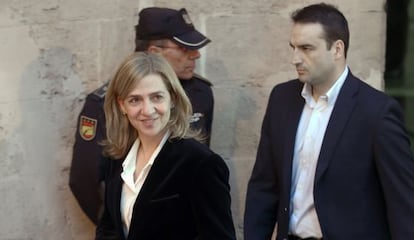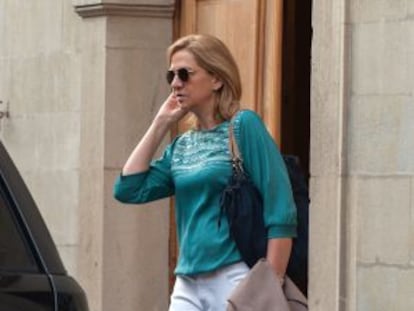The making of a royal scandal
The key events that led to Spain’s Infanta Cristina facing trial for tax fraud

1999. The Nóos Institute is created. The not-for-profit organization is originally called the Instituto de Investigación Aplicada and belongs to Diego Torres. No business activity takes place until 2003, when Infanta Cristina’s husband, Iñaki Urdangarin, is appointed its administrator.
2003. First deal between Jaume Matas and Urdangarin. The Balearics premier, of the ruling conservative Popular Party, signs a cooperation agreement with King Juan Carlos’s son-in-law worth €1.1 million.
2004-2006. €3.7 million. That is how much the Nóos Institute charges the Valencia regional government and the city of Valencia for organizing three editions of the Valencia Summit.
2005. The king’s emissary. The monarch tasks his legal advisor, the Count of Fontao, with investigating Urdangarin’s business dealings.
2008. ‘Palma Arena’ Judge. Investigating judge José Castro starts looking in to the sports arena in Palma, whose construction costs ballooned from €48 million to €110 million. This is the origin of the Nóos case.
2009. Outside Spain. The Dukes of Palma move to Washington, where Urdangarin works for Spanish telecoms giant Telefónica.
2011. The judge targets Torres in the investigation. From the moment his wife Ana María Tejeiro also faces preliminary charges, Torres becomes Urdangarin’s worst enemy.
December 2011. Preliminary charges filed against Urdangarin. La Zarzuela royal palace pulls him from official royal engagements after learning of Judge Castro's decision. A gag order is lifted.
2011 Christmas Eve speech. “Justice is the same for everyone,” the king says in his televised Christmas address to the nation in clear reference to his son-in-law.
February 25-26, 2012. Urdangarin testifies for 22 hours before Judge Castro. He blames his former associate Torres for everything and exonerates his wife Cristina.
January 20, 2013. “Boundless for-profit intention” is how the judge describes the activities of Urdangarin and Torres, who are slapped with a civil liability bond of €8.1 million.
January 23, 2013. Urdangarin is summoned to testify in court over tax fraud.
January 29, 2013. The judge summons Carlos García Revenga, secretary to the princesses and former treasurer at Nóos, as a formal target in the investigation.
April 3, 2013. Judge Castro files preliminary charges against Princess Cristina, but they are dropped after an appeal to the Palma Provincial Court, which recommends further investigation into possible tax crimes.
April 16. 2013. Defense calls for naming of Cristina as official suspect to be reversed because of a lack of “any facts that could constitute an offense.”
April 25, 2013. Tax returns. The infanta refuses to allow the Tax Agency to hand over her most recent tax returns to the judge as that would constitute a breach of her “fundamental right to privacy.”
The duke and duchess of Palma charged personal expenses such as trips to Africa, gourmet products and Harry Potter books via their company
May 7, 2013. The Palma de Mallorca court removes Cristina from the list of official suspects on the basis that there was no proof that she knew the business activities of her husband were illegal. However, the same writ clears the way for her to be named as a tax fraud suspect. The court tells investigating judge Castro to seek clarification from the Tax Agency over profits from the infanta’s stake in the company Aizoon, which is half hers and half her husband’s. Aizoon, according to the Tax Agency, was a “front company” created to facilitate fraud.
October 9, 2103. Money from Aizoon. Judge Castro discovers €150,000 in an account supposedly used by the infanta. The magistrate also establishes that she paid for lunches, flowers and children’s clothing with the company’s Visa Gold Card. The duke and duchess of Palma charged personal expenses such as trips to Africa, gourmet products, Harry Potter books and magazine subscriptions via their company.
December 9, 2013. Investigation stage concluded. Judge Castro completes the probe into the infanta’s business affairs, leaving a question mark as to whether she will eventually be named an official suspect once more. The magistrate only has two options: shelve the case or summon her again.
January 7, 2014. Named a suspect once more. Castro summons the infanta as an official suspect to question her about money laundering related to Aizoon, which received a lot of the funds obtained illicitly by Urdangarin. “The crimes against the Tax Agency committed by Iñaki Urdangarin would have been hard to commit without, at least, the knowledge […] of his wife […].”
February 8, 2014. Court appearance. In unprecedented testimony by a member of the royal family, Princess Cristina denies she had any knowledge of, or made any decisions in, her husband’s business dealings. “I trusted my husband,” the infanta tells Judge José Castro during her six hours of behind-closed-doors testimony at the Palma de Mallorca courthouse.
Urdangarin’ s crimes would have been hard to commit without, at least, the knowledge of his wife” Judge Castro
June 25, 2014. Closer to trial. Judge Castro decides to prosecute the infanta on tax fraud and money laundering offenses. In the 167-page writ, which sums up three years of investigation, Castro concludes that there are “overwhelming indications that doña Cristina has intervened, on the one hand, to obtain money for her own benefit, and on the other, to facilitate the means for her husband to do so […].”
June 26, 2014. The public prosecutor objects. An appeal against Castro’s decision is filed by the public prosecutor at the Palma court. “We still don’t know which concrete offenses and facts could see Cristina de Borbón named an official suspect,” it reads.
September 9, 2014. In the hands of the provincial court. The appeals filed by defense and prosecution are passed to the Palma provincial court, which must decide on the future of the infanta.
November 7, 2014. Tax offenses. The provincial court in Palma decides to maintain Cristina as an official suspect for tax offenses, but not for money laundering. Cristina de Borbón will face trial alongside her husband, Iñaki Urdangarin, in the Nóos case unless the Botín doctrine is applied, which would exempt her from sitting in the dock.
More information








































